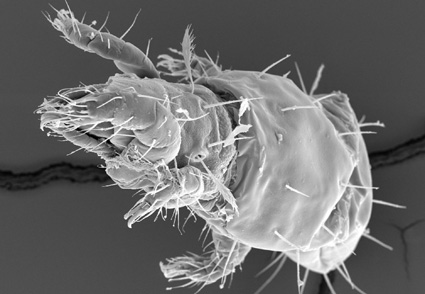Abstract
The morphology of juvenile instars of the mite Elliptochthonius profundus Norton, 1975 (Oribatida, Elliptochthoniidae) is studied. Comparative characteristics of juveniles of the representative genera in the superfamily Parhypochthonioidea is given based on our own data and available literature sources, and the major characteristics of larvae and nymphs are presented. It can be summarized that the juveniles of parhypochthonioides have the following character states: body trichoid, i.e., the postpedal scissure of gastronotum is clearly developed; body colour whitish or pale yellowish, lacking the strong cuticular sclerotization, where the flesh cuticle is sparsely foveolate or weakly microtuberculate; the juveniles of the different genera are generally similar, but differ from one another in the shape of bothridial seta, number of gastronotic setae, setations of gnathosomal, anogenital and epimeral regions and legs, development of the genital and aggenital plates and peranal segment.
References
Balogh, J. & Mahunka, S. (1979) New taxa in the system of the Oribatida (Acari). Annales Historico-naturales Musei Nationalis Hungarici, 71, 279–290.
Berlese, A. (1904) Acari nuovi. Volume II. Redia, 2, 10–32.
Grandjean, F. (1932) Au sujet des Palaeacariformes Trägårdh. Bulletin du Muséum National d’Histoire Naturelle, (2), 4, 411–426.
Grandjean, F. (1934a) Observations sur les Oribates (7e série). Bulletin du Muséum National d’Histoire Naturelle, (2), 6, 423–431.
Grandjean, F. (1934b) Les poils des épimières chez les Oribates (Acariens). Bulletin du Muséum National d’Histoire Naturelle, (2), 6, 504–512.
Grandjean, F. (1942) La chaetotaxie comparée des pattes chez les Oribates (2e série). Bulletin de la Société Zoologique de France, 67, 40–53.
Grandjean, F. (1949) Formules anales, gastronotiques, génitales et aggénitales du développement numérique des poils chez les Oribates. Bulletin de la Société Zoologique de France, 74, 201–225.
Jacot, A.P. (1936) More primitive moss mites of North Carolina. Journal of the Elisha Mitchell Scientific Society, 52 (2), 247–253.
Martinez, P.A. & Bernava Laborde, V. (2000) Gehypochthonius marianoi n. sp. (Acari: Oribatida), from sand dunes in coastal Argentina. Acarologia, 41 (3), 381–389.
Norton, R.A. (1975) Elliptochthoniidae, a new mite family (Acarina: Oribatei) from mineral soil in California. Journal of the New York Entomological Society, 83 (3), 209–216.
Norton, R.A. & Behan-Pelletier, V.M. (2009) Suborder Oribatida. Chapter 15. In: Krantz, G.W. & Walter, D.E. (Editors), A Manual of Acarology. Texas Tech University Press, Lubbock, pp. 430–564.
Norton, R.A. & Ermilov, S.G. (2014) Catalogue and historical overview of juvenile instars of oribatid mites (Acari: Oribatida). Zootaxa, 3833 (1), 1–132. https://doi.org/10.11646/zootaxa.3833.1.1
Norton, R.A. & Kethley, J.B. (1994) Ecdysial cleavage lines of acariform mites (Arachnida, Acari). Zoologica Scripta, 23 (3), 175–191. https://doi.org/10.1111/j.1463-6409.1994.tb00383.x
Norton, R.A., Kethley, J.B. Johnston, D.E. & OConnor, В.М. (1993) Phylogenetic perspectives on genetic systems and reproductive modes in mites. In: Wrensch, D.L. & Ebbert, M.A. (Editors), Evolution and Diversity of Sex Ratio in Insects and Mites. Chapman & Hall, New York, pp. 8–99.
Norton, R.A. & Palmer, S.C. (1991) The distribution, mechanisms and evolutionary significance of parthenogenesis in oribatid mites. In: Schuster, R. & Murphy, P.W. (Editors), The Acari – Reproduction, Development and Life-history Strategies. Chapman & Hall, London–New York, pp. 107–136.
Strenzke, K. (1963) Entwicklung und Verwandtschaftsbeziehungen der Oribatidengattung Gehypochthonius (Arach., Acari). Senckenbergiana Biologica, 44 (3), 231–255.
Subías, L.S. (2004) Listado sistemático, sinonímico y biogeográfico de los ácaros oribátidos (Acariformes, Oribatida) del mundo (1758–2002). Graellsia, 60 (número extraordinario), 3–305.
Subías, L.S. (2021) Listado sistemático, sinonímico y biogeográfico de los Ácaros Oribátidos (Acariformes: Oribatida) del mundo (excepto fósiles), 16ª actualización. 532 pp. Available from: http://bba.bioucm.es/cont/docs/RO_1.pdf (accessed March 2021).


